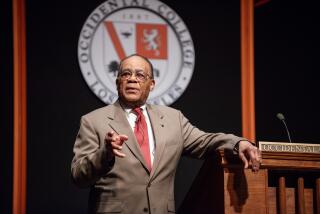PASSINGS: Donald A. Glaser, Jewel Akens
Donald A. Glaser
Nobel Prize-winning physicist
Donald A. Glaser, 86, a Nobel Prize-winning UC Berkeley physicist who invented a device called the bubble chamber, which allowed researchers to track the paths of high-energy atomic particles after collisions and which played a role in the discovery of new atomic particles, died in his sleep Thursday at his Berkeley home, the university announced. The specific cause was not given.
Glaser, a longtime UC Berkeley professor of physics, as well as of molecular and cell biology, won the 1960 Nobel Prize in physics for the bubble chamber, which allowed scientists to track the movements of electrons, protons and other particles. He did the research leading to his prize-winning invention while at the University of Michigan, where he began teaching in 1949.
The device, which Glaser compared to a “pressure cooker with windows,” worked by superheating a liquid such as xenon. When a particle passed through the liquid, it left a trail of bubbles that could be seen and photographed.
Glaser later turned his intellectual curiosity to molecular biology and later to neurobiology. In 1971, he joined two friends to found Cetus Corp., a biotechnology company that developed cancer therapies, among other research. In 1991, it was sold to California-based Chiron Corp., which later became part of Novartis.
Donald Arthur Glaser was born Sept. 21, 1926, in Cleveland, the son of Russian immigrant parents. He completed his bachelor’s degree in physics and math in 1946 at what is now Case Western Reserve University in Cleveland while also playing viola with the Cleveland Orchestra, according to a UC Berkeley press release. He earned a doctorate in physics and math from Caltech in 1950.
Jewel Akens
Singer had hit with ‘Birds and Bees’
Jewel Akens, 79, the R&B crooner whose song “The Birds and the Bees” vaulted him into short-lived fame in the mid-1960s, died Friday of complications from back surgery at Centinela Hospital Medical Center in Inglewood, said his wife, Eddie Mae.
Akens began his career in the late 1950s, working with Eddie Daniels and guitar legend Eddie Cochran, and later recorded singles with the Four Dots doo-wop group.
In 1965, he was singing with an ensemble called the Turnarounds when record producer Herb Newman brought them “The Birds and the Bees,” written by his teenage son. The rest of the group disliked the tune, but Akens decided to record it solo.
It became an instant hit, rising to the No. 3 spot on the Billboard pop chart in 1965.
“Let me tell you ‘bout the birds and the bees, and the flowers and the trees,” went the catchy tune, which was later covered by Dean Martin and others.
“No doubt you’re already singing the chorus,” wrote the Vancouver Province in 2002 when it featured the song on a top-10 list of one-hit wonders.
None of Akens’ later singles enjoyed the success of “The Birds and the Bees,” but he went on to tour with the Monkees in the 1970s and performed into his 70s.
Jewel Eugene Akens was born Sept. 12, 1933, in Houston, the seventh of nine children in a working-class family. He became interested in music early in life, singing for the church choir as a child.
In 1950, Akens moved with his family from Texas to Los Angeles, where he graduated from Fremont High School. There, he met his future wife, Eddie Mae, whom he married in 1952.
Times staff reports
More to Read
Start your day right
Sign up for Essential California for the L.A. Times biggest news, features and recommendations in your inbox six days a week.
You may occasionally receive promotional content from the Los Angeles Times.






